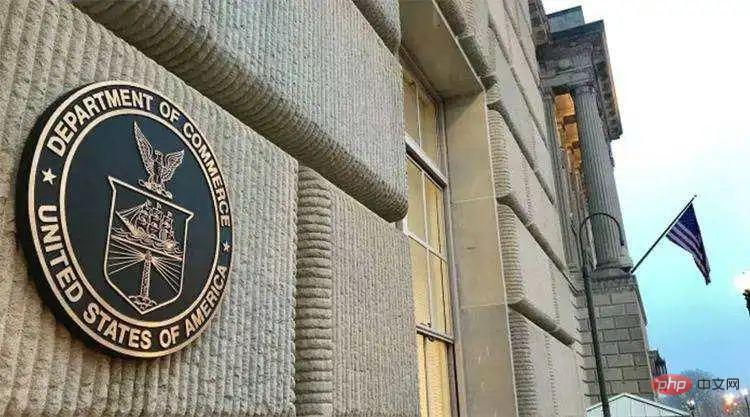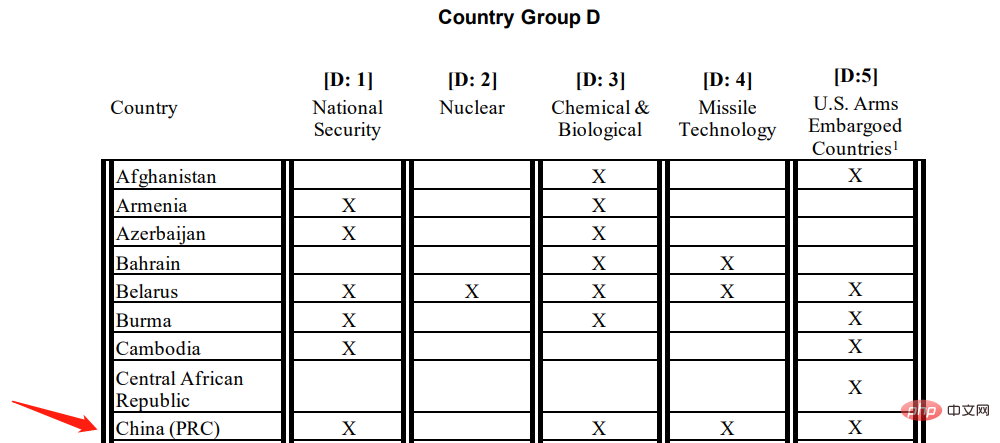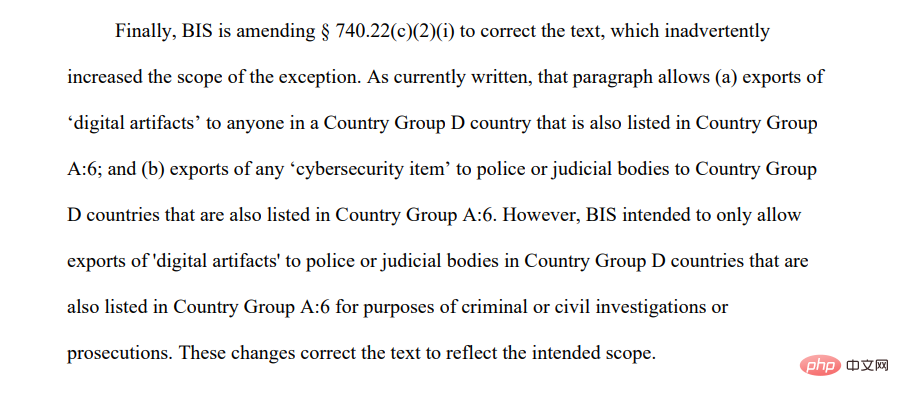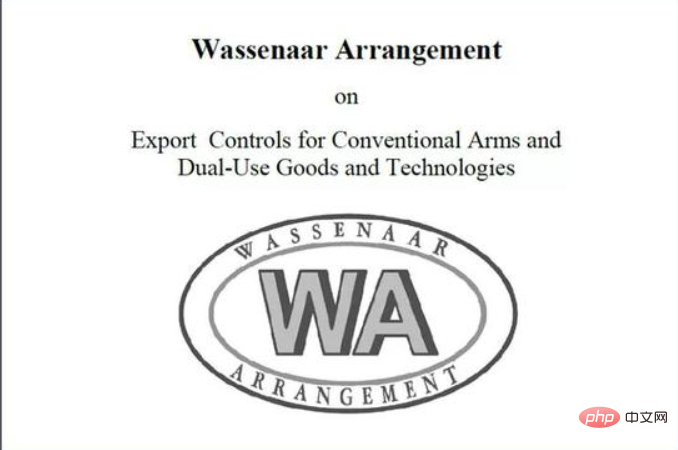 Technology peripherals
Technology peripherals
 AI
AI
 New U.S. Department of Commerce rules: Sharing security vulnerabilities to China without approval is prohibited, and Microsoft's objections are invalid
New U.S. Department of Commerce rules: Sharing security vulnerabilities to China without approval is prohibited, and Microsoft's objections are invalid
New U.S. Department of Commerce rules: Sharing security vulnerabilities to China without approval is prohibited, and Microsoft's objections are invalid
Recently, the U.S. Department of Commerce’s Bureau of Industry and Security (BIS) officially released the latest export control regulations for the field of cybersecurity.
Yes, it is the BIS that publishes the "Entity List" and "Trade Blacklist". In recent years, it can be regarded as an "old friend of Chinese netizens".
What is it this time? It is mainly about the management and control of network security and vulnerability information.
To put it simply, when U.S. entities cooperate with organizations and individuals related to the Chinese government, if security vulnerabilities and information are discovered, they cannot be directly announced and must first be reviewed by the Ministry of Commerce.
The reason is the tried-and-tested "national security" and the "need for counter-terrorism."

In fact, the new regulations announced this time are the final confirmation of the interim regulations (draft for comments) in October 2021. This regulation divides countries around the world into four categories: A, B, D, and E, with restrictive measures and strictness gradually increasing.
China is classified in Category D, which is "restricted countries and regions", and Category E is "comprehensive embargoed countries".
This regulation establishes new control methods for certain network security projects for the purpose of "national security and counter-terrorism considerations."
At the same time, BIS also added a new exception to authorize network security exits. The core content is to authorize the export of these cybersecurity items to most destinations, but not with the exceptions mentioned above.
BIS believes that these controlled projects may be used for surveillance, espionage, or other acts aimed at sabotage.
In addition, the regulations also amend the export control classification numbers in the Commerce Control List.

The new BIS regulations divide countries around the world into four categories: A, B, D, and E. Category D is the most concerned and restricted countries and regions.
As shown in the picture above, China is classified in category D.
According to the requirements of the new regulations, when entities cooperate with relevant government departments or individuals in Class D countries and regions, they must apply in advance and obtain permission before they can send potential cross-border Network vulnerability information.
Of course, there are exceptions to the terms. If it is for legitimate cybersecurity purposes, such as public disclosure of vulnerabilities or incident response, no advance application is required.
As you can see, China’s national security, biochemical, missile technology, and U.S. arms embargo are all marked with an X.
The document states that licensing requirements for individuals acting on behalf of governments are necessary to prevent those acting on behalf of governments in Group D countries from obtaining "cyber licenses for engaging in activities contrary to the national security and foreign policy interests of the United States." Safety Project".

Without this requirement, it may result in governments in Class D countries having access to these projects.
The requirement adopted by BIS means exporters must in some cases check the government affiliations of individuals and companies they work with.
However, due to the limited scope and applicability of the licensing requirement, BIS believes that the requirement will protect U.S. national security and foreign policy interests without unduly impacting legitimate cybersecurity activities.
At the same time, BIS also revised clause § 740.22(c)(2)(i), which actually expanded the scope of the exception.

The current terms allow the export of digital products to Group D countries, or the export of any cybersecurity items to Group D countries for police or judicial agencies.
However, BIS actually only intends to allow the export of digital products to police or judicial agencies in Group D countries for the purposes of criminal or civil investigations or prosecutions.
It can be said that these changes reflect the expected opinions.
Microsoft objects, invalid!
Regarding BIS’s new regulations, domestic technology giants in the United States are not monolithic. The software giant Microsoft has clearly expressed its objections.
As early as last year, after this regulation was released for consultation, Microsoft submitted its objections to this document in the form of written comments in the comment section.

Microsoft stated that if individuals and entities involved in cybersecurity activities are restricted due to ties to the government, it will greatly suppress the global cybersecurity market. Capabilities of currently deployed routine cybersecurity activities.
Many times, when companies are unable to determine whether the other party is related to the government, they can only give up cooperation in the face of compliance pressure.

Microsoft’s opposition is not surprising.
The current vulnerability sharing mechanism is very important to Microsoft’s software development ecosystem. Many times, Microsoft needs to analyze vulnerabilities through reverse engineering and other technologies before releasing relevant patches and upgrades. Once the vulnerability sharing mechanism is destroyed, it will directly reduce the speed of Microsoft's discovery and repair of vulnerabilities.
Microsoft proposed that BIS should further clarify the definition of "government end users", or at least clarify which individuals or entities may be covered under this definition.
When BIS released the final draft of the regulation, it mentioned Microsoft's objections but did not name them and stated that "BIS does not agree with this opinion."
BIS mentioned in the document:
"Companies have stated that restrictions on people representing 'government end users' will hinder cross-border cooperation with cybersecurity personnel because of the difficulty in working with these Before communicating with people, check whether they have government connections. The company recommended that this requirement be removed or modified. BIS disagreed with this recommendation."
The final decision, released last week, is consistent with There are no major changes in the content compared to the draft released for comments last October.
However, the regulations adopted some opinions from the research community, further narrowed the scope of security vulnerabilities that need to be verified, and added temporary exceptions.
That is: if it is for legitimate network security purposes, such as disclosing public vulnerabilities or responding to security incidents, no review is required.

#This exception clause is largely to create necessary conditions for the normal operation of the open source community.
While Microsoft thanked BIS for revising the rules, it also stated that it was not sure whether such exceptions could solve the actual problem.
"What is allowed to be directly disclosed and what is not allowed to be disclosed is still in a state of confusion. What activities require a license cannot be determined at this stage. We are worried that for those technologies that cannot be fully classified into specific use categories , the license application will be very cumbersome."
BIS acknowledged Microsoft's concerns, but at the same time insisted that this provision would do more good than harm to U.S. national security.
Similar to the "Wassenaar Agreement"
In fact, as early as October 2021, BIS issued regulations "prohibiting the export of offensive network tools" , preventing U.S. entities from selling offensive cyber tools to China and Russia.

U.S. Commerce Secretary Gina Raimondo said, “Implementing export controls on certain cybersecurity items is an appropriate approach to protect U.S. national security from malicious intent. The infringement of online behavior and to ensure legitimate network security activities."
BIS further stated that the current rules are also within the framework of the "Wassenaar Agreement", that is, the "About Standing Orders" Wassenaar Agreement on Export Controls of Arms and Dual-Use Goods and Technologies.

The "Wassenaar Agreement" stipulates that member states shall decide on their own to issue export licenses for dual-use items of sensitive products and technologies, and on a voluntary basis Notify relevant information to other member states of the Agreement on a basic basis.
In fact, the agreement is actually controlled by the United States to a large extent and affects the export control regulations of other member countries, becoming an important tool for the West to implement high-tech monopoly on China.
The agreement controls the export policy of "military and dual-use technologies". There are 42 agreement countries, including major developed countries such as the United States, Britain, France, Germany, and Japan. Although Russia is also a party to the agreement, it is still one of the embargo targets.
The above is the detailed content of New U.S. Department of Commerce rules: Sharing security vulnerabilities to China without approval is prohibited, and Microsoft's objections are invalid. For more information, please follow other related articles on the PHP Chinese website!

Hot AI Tools

Undresser.AI Undress
AI-powered app for creating realistic nude photos

AI Clothes Remover
Online AI tool for removing clothes from photos.

Undress AI Tool
Undress images for free

Clothoff.io
AI clothes remover

AI Hentai Generator
Generate AI Hentai for free.

Hot Article

Hot Tools

Notepad++7.3.1
Easy-to-use and free code editor

SublimeText3 Chinese version
Chinese version, very easy to use

Zend Studio 13.0.1
Powerful PHP integrated development environment

Dreamweaver CS6
Visual web development tools

SublimeText3 Mac version
God-level code editing software (SublimeText3)

Hot Topics
 1359
1359
 52
52
 Gitee Pages static website deployment failed: How to troubleshoot and resolve single file 404 errors?
Apr 04, 2025 pm 11:54 PM
Gitee Pages static website deployment failed: How to troubleshoot and resolve single file 404 errors?
Apr 04, 2025 pm 11:54 PM
GiteePages static website deployment failed: 404 error troubleshooting and resolution when using Gitee...
 How to achieve gap effect on the card and coupon layout with gradient background?
Apr 05, 2025 am 07:48 AM
How to achieve gap effect on the card and coupon layout with gradient background?
Apr 05, 2025 am 07:48 AM
Realize the gap effect of card coupon layout. When designing card coupon layout, you often encounter the need to add gaps on card coupons, especially when the background is gradient...
 Does H5 page production require continuous maintenance?
Apr 05, 2025 pm 11:27 PM
Does H5 page production require continuous maintenance?
Apr 05, 2025 pm 11:27 PM
The H5 page needs to be maintained continuously, because of factors such as code vulnerabilities, browser compatibility, performance optimization, security updates and user experience improvements. Effective maintenance methods include establishing a complete testing system, using version control tools, regularly monitoring page performance, collecting user feedback and formulating maintenance plans.
 Where to get the material for H5 page production
Apr 05, 2025 pm 11:33 PM
Where to get the material for H5 page production
Apr 05, 2025 pm 11:33 PM
The main sources of H5 page materials are: 1. Professional material website (paid, high quality, clear copyright); 2. Homemade material (high uniqueness, but time-consuming); 3. Open source material library (free, need to be carefully screened); 4. Picture/video website (copyright verified is required). In addition, unified material style, size adaptation, compression processing, and copyright protection are key points that need to be paid attention to.
 How to obtain real-time application and viewer data on the 58.com work page?
Apr 05, 2025 am 08:06 AM
How to obtain real-time application and viewer data on the 58.com work page?
Apr 05, 2025 am 08:06 AM
How to obtain dynamic data of 58.com work page while crawling? When crawling a work page of 58.com using crawler tools, you may encounter this...
 Why does negative margins not take effect in some cases? How to solve this problem?
Apr 05, 2025 pm 10:18 PM
Why does negative margins not take effect in some cases? How to solve this problem?
Apr 05, 2025 pm 10:18 PM
Why do negative margins not take effect in some cases? During programming, negative margins in CSS (negative...
 Why are the purple slashed areas in the Flex layout mistakenly considered 'overflow space'?
Apr 05, 2025 pm 05:51 PM
Why are the purple slashed areas in the Flex layout mistakenly considered 'overflow space'?
Apr 05, 2025 pm 05:51 PM
Questions about purple slash areas in Flex layouts When using Flex layouts, you may encounter some confusing phenomena, such as in the developer tools (d...
 Why do search engines still display old titles after the website title keyword is updated?
Apr 04, 2025 pm 09:00 PM
Why do search engines still display old titles after the website title keyword is updated?
Apr 04, 2025 pm 09:00 PM
Why are search engines not displayed after the website title keywords are updated? When optimizing a website, many webmasters will modify the website's SEO settings and structured data, hoping...



